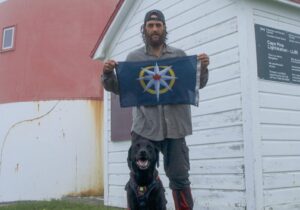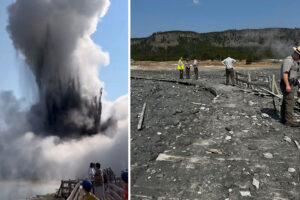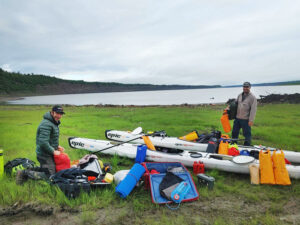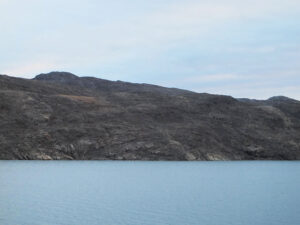I was jolted awake by another violent gust of wind; the driver mumbled an apology as he struggled to keep the van on the road. Away to the South, the North Atlantic whipped into a frenzy, waves pounded the blackened shoreline and white horses streamed from a blurred horizon. We had left Reykjavik 7 hours before on the No. 51 Public Straeto bus, bound for the Jokulsarlon lagoon and the start of our expedition. Our plan was to traverse Iceland from South to North via the Vatnajokull glacier, making the first packraft descent of the Skjalfandafljot river from the source to the sea and the first unsupported ski and raft traverse of Iceland.

Dan, Gareth and Rich standing on the Diamond Beach ready to start the expedition
Jokulsarlon
We shouldered our packs for the first time and stepped on to the Diamond Beach, the black sand flecked with glacial ice, warped and moulded by the relentless onslaught of the breaking waves. We turned our backs to the sea, lifted our hoods to the frigid wind and made our way up the beach. The moraine lining the shores of the lagoon gave us some welcome shelter and we pitched our tent in the fading light, the first spits of rain from a slate-grey sky ruining any chances of dinner with a view. We had been planning this journey for 18 months, the idea conceived on the glaciers of Western Greenland two years before, as we listened to the glacial rivers deep within the belly of the ice sheet thundering away towards the coastal mountains and the sea. The discussion turned to Iceland, with its mist shrouded peaks, vast glaciers, black, desolate interior and mighty rivers. It was designed as a journey the three of us would make together, good friends and team mates, going into the wilds in search of a grand adventure. Devastatingly, Dan had to withdraw from the expedition on that first evening due to ill health. We’d invested so much to get this far and after much discussion and deliberation Rich and I chose to continue, knowing we’d have been stronger as a three but hoping we still had the skills and determination to make it through as a pair.

Walking towards the Jokulsarlon lagoon and our first camp. The Breidamerkerjokull glacier and Esjufjoll mountains in the distance.
The following morning the cloud level had descended. Across the lagoon the Esjufjoll mountains, our gateway to the Vatnajokull, had disappeared behind a curtain of grey. A light wind ruffled the surface of the water, grey seals bobbed and splashed, watching with interest as we prepared our rafts. We stowed the majority of our gear inside our boats with only essential items strapped to the bow, skis tied down the sides and our pulks lashed onto the back. The three of us paddled out into the lagoon, weaving amongst the icebergs before an emotional farewell saw Dan turn and paddle for home.

Paddling amongst the Icebergs across the Jokulsarlon lagoon.
It was an 8km paddle across open water before reaching the bay from which we would begin the journey on foot. The wind rose and turned, bombarding us from the East, bringing with it a drenching rain. Hollow booms from dying icebergs echoed across the grey. Waves broke against our rafts, stinging our faces and coating us in spray. Occasionally a berg would cleave or roll, shifting position and sending percussion waves to rock our toy boats. Vast palisades of white and pastel blue choked the bay, challenging our exit navigation. We landed our packrafts and repacked our gear into our backpacks. Bidding farewell to the Selkies that had accompanied us across the water, we began our trek to the foot of the glacier.
Vatnajokull
After a night of wind and torrential rain, we woke to a monochrome world, our red jackets and yellow tent stark against the ice and rock. We hauled our heavily laden sleds across a collection of melt-rivers to the base of the glacier, the water wider and deeper than the night before due to the incessant rain. The cloud level had dropped further still and soon after beginning our ascent up the lower slopes of the Breidamerkurjokull, we were engulfed in white.

Our first steps on the Breidamerkerjokull glacier towards the Vatnajokull
We were glad to be on the ice, dragging our gear, rather than suffering through the backbreaking toil of carrying 50kg each on our backs. Despite our best efforts to reduce weight and only take the bare essentials, we still had a mountain of gear – a bi-product of attempting a multi-disciplinary, unsupported expedition. Packrafts, drysuits, skis, tent, sleds, food – enough kit to survive the Icelandic interior and a wild river for three weeks. The ice beneath our feet was crystalline, its surface flecked with rock and gravel and pocked with small holes carved by the falling rain. We made our way up the ever-steepening slope, still well below the snowline. Navigation was challenging in the low cloud and our progress was hindered by a maze of crevasse fields. We camped that evening beneath the Esjufjoll mountains, our efforts rewarded by a break in the weather revealing the craggy spires and tumbling glaciers to our North and West.

Our first glimpse of the sun above the Esjufjoll mountains
Our second day on the glacier saw us clear the troublesome crevasse fields and we walked for the best part of the morning with good visibility. We travelled now on blue ice or rotten, soft snow before reaching the snowline at around an elevation of 800m. Shortly after strapping on our skis, the weather turned, bringing wind and driving snow. We fought our way through the white-out, the gradient of the glacier kicking up sharply as we neared the Vatnajokull plateau towards the end of the day. We collapsed, exhausted, into our tent, the blizzard still blowing hard outside. A fitful night was spent reinforcing the tent and trying to prevent snow accumulating on the lee side, the warnings of broken, buried tents on Iceland’s glaciers, hanging uneasily in our minds. We woke the following morning to water dripping on our faces and sleeping bags. Temperatures had risen in the night and the driving snow was replaced by a steady, malevolent rain. Spindrift that had worked its way through the vents and settled on the inner tent was now melting and we found ourselves sleeping amongst puddles, our down jackets and sleeping bags soaked through. With our spirits low, we pulled on our wet weather layers and headed out into the rain and our first day on the Vatnajokull plateau.

Rich navigating across the ice sheet
The Kolduksvislarjokull glacier, our exit point from the ice sheet, was approximately 100km Northwest of our current location on the Breidamerkurjokull glacier; we hoped to reach it in 5 days. After leaving the coastal mountains behind, our days on the Vatnajokull were a world of never-ending white, a cap of clouds blown by the northerly winds, sitting on the ice. The spectral promise of clear skies and a warm sun was only ever a chance gust of wind away, yet remained elusive. Those long, fluid hours of skiing felt empty and isolated, as if we were adrift on a glacial ocean, the ice running away unhindered to the white horizon in every direction. The damaging winds and storms that we had worried about and trained for, never materialised, the success of the journey threatened only by broken bindings inventively fixed and soggy down layers laboriously dried by the heat of our stove.

Early morning skies high on the Vatnajokull plateau
The Grimsvotn volcano lay in hibernation south of our route, the cliffs and crevasses of the caldera visible from our high point, 40km to the North. Temperatures dropped and winter returned. A bitter wind from the North arrived, bringing nights of freezing rain and mornings cocooned in rime ice. At the Western edge of the ice sheet we neared two sub-glacial volcanic lakes, marked by two huge craters in the ice, the East and West Skaftakatla. We skirted North with caution, the ice sloping away Southwest as if falling into a vortex, our pulks gently drifting toward them like filings to a magnet. Our safe vantage point afforded views of the ring of crevasses plunging deep into the ice. The air was tinged menacingly with sulphur.
We pushed on through our last day on the ice under clear skies. Cresting the final rise before our descent off the glacier, we caught our first site of the Icelandic Highlands. Dark and forboding, the black interior proved intimidating after our days in the white snows of the Vatnajokull. We pitched our tent on the ice one final time, the light in the Western sky retreating toward dusk, rivulets of cloud on the horizon rising like smoke from the embers of a dying fire.
Skjalfandafljot – The River of the Trembling Spirit
From our final glacier camp we stared down into the Vonarskard, one of the most remote and desolate of Iceland’s high mountain passes. It is a haunting place, steeped in legends of ghosts and outlaws, a place where the Vikings feared to tread and the old gods still roam. Our entrance into the Vonarskard was shielded by a wall of glacial moraine, 30-40 metres high and skirting the entire base of the glacial tongue. We eventually found a weakness in the defences, a small melt-stream cutting its way through the shale and rock, enough for us to clamber over and haul our sleds through. Finally off the glacier and through the moraine, we dismantled our pulks, modified from their original design to be unscrewed and split into two pieces then stacked together, allowing them to be easily lashed to our rafts and packs. With our rucksacks packed, we descended into the river valley in search of the source.

Escaping the vatnajokull, negotiating the moraine field at the base of the Kolduksvislarjokull glacier
The valley below us was roughly 2 kilometres wide running south to north, with the Hofsjokull ice cap dominating the Western skyline. We followed the valley north, the soft black alluvial sand disintegrating beneath each step with a puff of dust. After three hard-won kilometres we saw the glint of distant water, a sheen of silver filling the valley floor. The ground beneath our feet turned boggy and wet, sucking at our boots, then swallowing our legs up to our knees, the weight of our packs forcing us deeper into the tar-like mud. Another hour of walking brought us to a confluence of glacial streams pouring from the Vatnajokull in the East and the Hofsjokull to the West. The result was a thin layer of water stretching across the valley, flashed silver by reflections of a bright sky, brushed with high cirrus. We had found the source of our river. Soon, the river was ankle deep, enough for us to inflate and drag our rafts. Glad to be rid of the weight on our shoulders, we donned our dry suits and took our first steps towards the sea.

Searching for the source of the river

Our packrafts at the source of the Skjalfandafljot River.
It was not long before the river gained shape and volume, following the contours of the land. Paddling now, we followed the sweeping braids of the river as it swayed gently east and west across the low river valley. The v-shaped valley tightened at its mouth, the river gaining pace as it funnelled into a single fast-moving body. Gliding unhindered around a rocky outcrop, it expanded again into an empty, open plain, releasing its coiled energy into a series of twisting braids. We felt the land falling away gradually before us, the river growing in size, fed by numerous melt-water streams from the surrounding snow-capped hills. Gaining volume, the river carved its way through the landscape, the last of winter’s snow pack forming steep walls of snow and ice.
Snow began to fall, gently at first, then harder, whipped by a northerly headwind, rising to a gale, obscuring our view of the river ahead. We were moving fast now, at the whim of the current. The river filed again into a single channel and we snaked along under overhanging seracs of ice, our previous lighthearted chatter swiftly turning to thoughts of vigilance and concern. We landed our packrafts at the first sandbank we could find; it was time to discuss and reassess. We had made 15 kilometres since we joined to river and we were elated by our progress. Confident in our safety and ability to exit the river if needed, we decided to push on. The channel swung around a low ridge of ice, the canyon ahead grew narrower and deeper, the water quickening. The river fell away, melting into the horizon. We could no longer pick its course against a wall of rising spray and falling snow. The headwind brought with it a guttural, grinding roar. Water smashing against rock, hammer against anvil. Our worst fears materialised. We scoured the surrounding walls in desperation, searching for an escape route. Nothing but smooth sided ice. To save ourselves being swept down the rapid we jumped out of our boats. The water pressed thick and heavy against our thighs but we were able to stand and arrest our progress down river. Slowly we edged our way down the first small rapid, one nervous step at a time. Wrestling with the current we forced our way across to a slither of sand next to the canyon wall and secured our boats. Scrambling and slipping our way up the ice and out of the canyon we stared down river in disbelief. From our elevated vantage point we could see a maelstrom of churning whitewater the end of which was marked with a series of small waterfalls. We had narrowly avoided disaster and scolded ourselves for poor decision making. We had ignored our ‘no paddling in canyons policy’ at the first opportunity. It was 5pm, dusk was beginning to tighten its grip on the land and we were getting cold. The day seemed over, but not before we had hauled our boats up the canyon walls and carried them to a suitable camp ground. After a little under half a kilometre, we found a single bank of grass large enough to take a tent amidst a boulder-strewn desert. We collapsed inside, exhausted and beaten.

The ice-walled whitewater canyon
We left our river now as it continued its thunderous course through a series of deep whitewater canyons. It would be three days and around forty kilometres of walking before we would be reunited. Before us lay a gently undulating plateau of black sand. Whaleback ridges etched with snow-patch camouflage extended to the horizon. Thin sunlight stretched across the sky, giving only the faintest hint of warmth. Thick cumulus clouds herded to the North. Soft, dusty sand and sucking mud were our constant companions for three days. Fields of lava slowed our progress further still, a shattered landscape, born of fire and violence. As we walked, we began to see a transition away from the empty highland desert. Spring rose up around us and wetlands emerged. Wading birds had started to return. Banks of grass and flowers woke from their slumber beneath the snow. Highland streams brought movement, energy and life to a scarred and blackened land.
We intercepted the river as it coursed through a steep-sided valley. Its character had changed since we left it, wider now, full and fast flowing. We plodded on, our pre-expedition study of satellite images having warned us that an impending waterfall or rapid stalked this section of river, unmarked on any maps. Concentrating hard on studying the river we barely noticed our river bank disappearing into the mountainside. The river swung east towards a wall of cliffs and dropped 20 metres into a canyon trapping us between river and mountain. Fording the river seemed our only choice. We loosened our packs, unclipped our waist belts and entered the water. The piercing cold gripped like a vice, immediately numbing my feet. We reached the middle unscathed, the water knee deep and running fast. Without warning, I plunged into my waist almost losing my footing. I dug my boots in and gripped my poles, the weight of the water against my body slowly edging me downstream. I looked back over my shoulder towards the falls, the water raced away towards the drop off. No time to shed our packs and get to the bank if we went in. I was utterly terrified. No room for error now, no time for weakness or fatigue. Going back would see us trapped; pressing on was our only option. Finally, the water became shallower; the terrifying pressure threatening to sweep us to our doom lessened. We collapsed on the opposite bank, wide-eyed and trembling with cold and fear. We sat for a while out of the wind, behind the only rock feature we could find, and ate some chocolate in silence. Both of us knew we’d made a stupid decision, one that had pushed us dangerously close to the edge of disaster in an environment that would have shown us no mercy. We’d got away with it this time but vowed never again to underestimate to power of the wilderness through which we travelled. That evening we climbed into our tent soaked through, freezing and exhausted, a gentle snow beginning to settle. I thought about home. The lonely honk of a greylag goose, empty and mournful, echoed down the valley toward a darkening sky.

Highland waterfall unmarked on any maps
Nearly two weeks in now and the relentless headwinds, the driving ice and snow, the damp, and above all the grinding weight of our gear was beginning to tell. We were both becoming exhausted, shivering cold through the nights despite good sleeping bags, our food just not enough to keep pace with our calorific demands. We needed to eat more food but that meant we had to cover more distance or risk running out of supplies. We made a crucial decision – it was time to go for broke. With extra food in our bellies and miraculously warmer, we made ambitious plans for the days ahead, knowing our grit would be tested like never before, if we were to savour success. Not making the distances each day would mean hunger and failure.
The valley opened again into a wide plain and the river followed a braided path for the next 25 kilometres. Launching our boats early, we paddled under a pale, watery sun. A light wind skimmed the surface of the water; it was bitterly cold. Icicles formed on our paddles, helmets and beards. Crusts of rime ice flaked off our drysuits as we moved. Later in the day the wind rose and the snow returned making navigation difficult. We knew that at the end of this valley the river raced into a gorge shortly before reaching the Hrafnabjargafoss waterfall. We had to be off the river before then. We crawled along hugging the bank for the last few kilometres, a curtain of snow hiding any features ahead. Out of the murk loomed towering basalt cliffs, black gates beyond which we could hear the hollow booming call of the whitewater. We had reached the canyon.

Hrafnabjargafoss
The following days saw us walk through snow-covered fields of lava, past the Hrafnabjargafoss and Aldeyjarfoss waterfalls, pillars of basalt forming an amphitheatre of raging currents and swirling winds. These falls signalled the start of the lowland river and we thought for the first time that we might just make it all the way across the country.

Aldeyjarfoss
Only the Godafoss waterfall stood between us and the coast now and we reached it after another day’s paddle. A mighty horseshoe-shaped cascade, the entire volume of the Skjalfandafljot river tumbled fifteen metres into the canyon below. Tourist buses cluttered the car park, people milled around taking photos, the smell of food wafted towards us from the café. We suddenly felt self-conscious and vulnerable; filthy, bearded, eyes hollow with fatigue. We grabbed our packs and walked back into the wild, only 30 kilometres until the Arctic Ocean; we weren’t ready for civilisation just yet.

Godafoss
Our final day started fresh and bright. New snow lay on the ground and the sun hung high in a pastel sky. We walked until lunchtime through pine forest plantations, following the tracks of Arctic foxes amongst the trees. We were on the river for the last time by early afternoon, the current running fast and strong. We chatted and drifted in the sunshine, the calls of Whooper Swans and Greylag geese drifting with us downriver. Ten kilometres from the coast we were hit by our first squall, the weather hounding and malevolent to the end; first throwing a violent headwind from the North, then engulfing us in snow. Our steady progress slowed to a crawl; waves whipped up, breaking over the bow of our rafts; fat sticky snowflakes stung our eyes and filled our mouths. These squalls would roll in from the sea like clockwork every ten to fifteen minutes. The last stretch of river took us three hours to paddle.
We could hear the ocean breakers now as they pounded the thin spit of sand that separated our river from the sea. The Skjalfandafljot opened finally into a wide estuary, riven with submerged sand banks, the main channel hidden. It felt like our final test as we dragged our rafts from sand bank to sand bank amongst the swirling snow. At last we saw the cliffs and the river mouth. The wind dropped. A pulse of sunlight through a broken sky brought an ethereal glow to the lagoon through which we now paddled. It was as if we had been released and allowed to finish our journey, the malevolent spirit of Iceland’s weather finally, begrudgingly, allowing us to pass.

The final paddle, the end in sight.
A grey seal bobbed beside us; we had come full circle. We landed our boats at the mouth of the river and stood for a while staring out to sea.

The mouth of the Skjalfandafljot River and the Arctic Ocean

Gareth and Rich on the beach at Skjalfandi Bay






